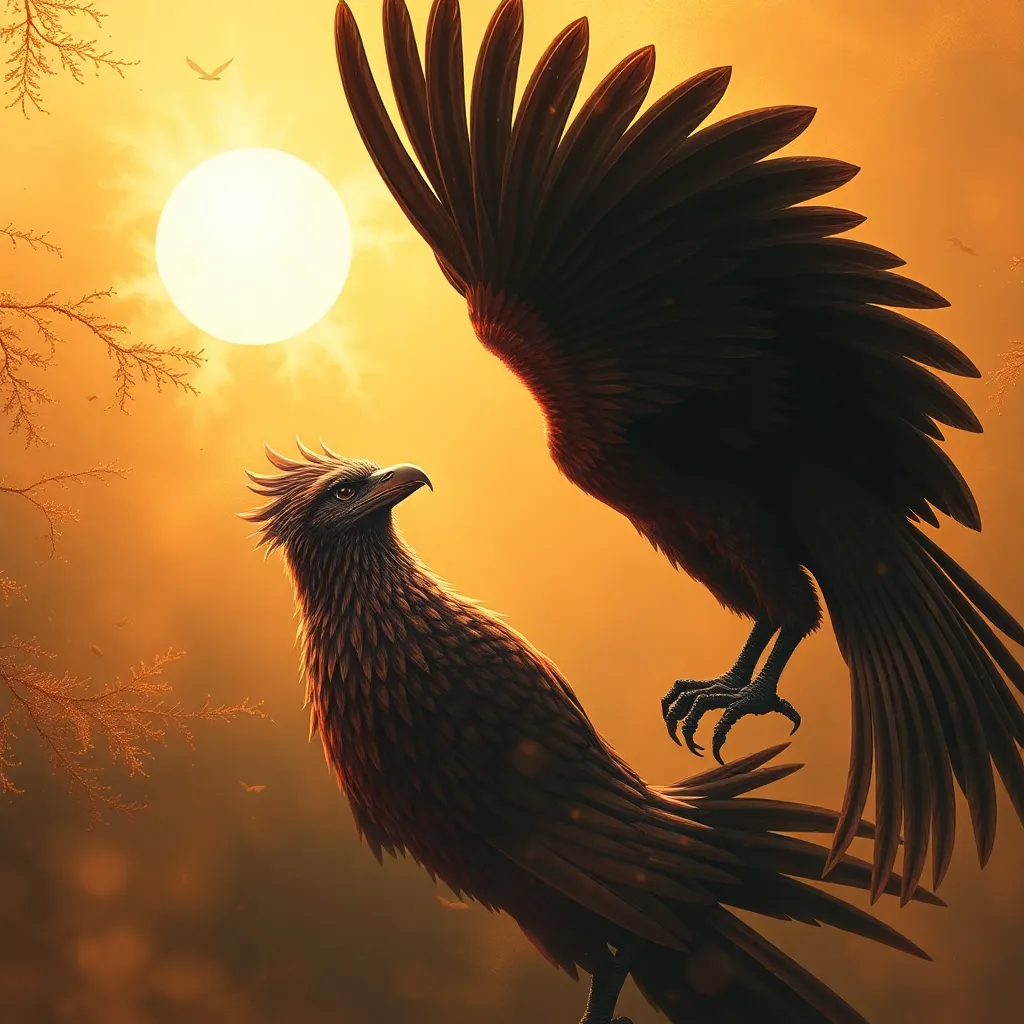Thunderbird: Guardian of the Skies in Northwest Coast Mythology
I. Introduction
Northwest Coast mythology is a rich tapestry of stories that reflect the deep connection between the Indigenous peoples of the region and the natural world. Among the myriad of creatures that populate these narratives, the Thunderbird stands out as a powerful symbol of strength, protection, and the forces of nature. This majestic being is not just a character in stories; it embodies the cultural values, beliefs, and environmental interactions of the tribes that revere it. This article aims to explore the significance of the Thunderbird within Northwest Coast mythology, examining its origins, symbolism, and enduring legacy.
II. The Origin of Thunderbird in Mythology
The Thunderbird’s origins are deeply rooted in the creation stories of various Northwest Coast tribes. These narratives often portray the Thunderbird as a creator or transformer, responsible for shaping the world and its inhabitants.
A. Creation stories featuring the Thunderbird
In many traditions, the Thunderbird is depicted as a being that brought rain and thunder to the earth, creating the conditions necessary for life. It is often said that the Thunderbird created the first mountains and valleys, and its powerful wings caused the winds to blow.
B. Variations in Thunderbird myths among different tribes
While the general concept of the Thunderbird is consistent across many tribes, each has its unique variations and stories:
- Tlingit: The Tlingit people view the Thunderbird as a guardian of the supernatural and a mediator between humans and the spirit world.
- Haida: Among the Haida, the Thunderbird is often depicted in their totem art and is associated with strength and bravery.
- Nuu-chah-nulth: This group tells tales of the Thunderbird battling the Whale, symbolizing the struggle between land and sea.
C. Role of Thunderbird in the natural world
The Thunderbird is not only a mythological figure but is also seen as an essential part of the natural order. It is believed to control the weather, bringing storms and rain that nourish the earth.
III. Physical Description and Symbolism
The Thunderbird is often depicted in art and stories as a massive bird with striking features that emphasize its power and significance.
A. Traditional depictions of the Thunderbird
Artists typically portray the Thunderbird with large wings, a fierce beak, and elaborate feather patterns. Its eyes are often depicted as fiery, symbolizing its connection to the sun and lightning.
B. Symbolic meanings associated with the Thunderbird
The Thunderbird’s imagery carries various symbolic meanings:
- Power: The Thunderbird is a symbol of immense strength and authority.
- Protection: It is regarded as a guardian spirit, protecting the people and their communities.
- Transformation: As a force of nature, the Thunderbird represents change and renewal.
C. Thunderbird as a representation of power and protection
In many cultures, the Thunderbird is seen as a protector of the people. Its presence is believed to ward off evil spirits and ensure the prosperity of the community.
IV. Thunderbird’s Role in Nature
The Thunderbird’s connection to the natural world is profound, as it is often associated with weather phenomena that are vital to the ecosystem.
A. Thunderbird’s connection to storms and weather
The Thunderbird is frequently linked to thunderstorms, lightning, and rain. It is believed that the flapping of its wings creates thunder, while its movements dictate the arrival of storms.
B. The relationship between Thunderbird and other natural elements
In many myths, the Thunderbird interacts with other elements of nature, such as:
- Water: It is considered a bringer of rain, crucial for the growth of plants and the survival of animals.
- Wind: The Thunderbird’s flight generates winds that influence the climate.
- Fire: It is often associated with lightning, which can start fires that rejuvenate the land.
C. Thunderbird as a guardian of the balance in nature
As a powerful entity, the Thunderbird is seen as a guardian of the balance in nature, ensuring that the elements coexist harmoniously. Its role is vital in maintaining the ecosystem’s health.
V. Thunderbird in Cultural Practices
The Thunderbird plays a significant role in the cultural practices of Northwest Coast tribes, influencing rituals, storytelling, and art.
A. Rituals and ceremonies involving the Thunderbird
Many tribes hold ceremonies to honor the Thunderbird, seeking its blessings for good weather and bountiful harvests. These rituals often involve songs, dances, and offerings.
B. The role of Thunderbird in storytelling and oral traditions
The Thunderbird is a central character in numerous stories passed down through generations. These tales often convey moral lessons, cultural values, and the importance of respecting nature.
C. Artistic representations of the Thunderbird in totem poles and carvings
Artistic depictions of the Thunderbird are prevalent in totem poles, carvings, and traditional regalia. These artworks serve as expressions of cultural identity and preserve the stories associated with the Thunderbird.
VI. The Thunderbird in Modern Context
In contemporary society, the Thunderbird continues to hold significance, evolving in its representation while maintaining its cultural roots.
A. Contemporary interpretations of the Thunderbird
Modern interpretations often reflect a blend of traditional beliefs and contemporary issues, such as environmental stewardship and resilience.
B. Influence of Thunderbird in popular culture and media
The Thunderbird has inspired various forms of media, from literature and film to visual arts. It often symbolizes strength and resilience in the face of challenges.
C. Preservation of Thunderbird mythology in modern Indigenous communities
Many Indigenous communities actively work to preserve Thunderbird mythology through education and cultural revitalization efforts, ensuring that future generations understand its significance.
VII. Comparisons with Other Mythological Creatures
The Thunderbird shares similarities with other mythological beings across cultures, often representing similar themes of power and protection.
A. Similarities between Thunderbird and other mythological beings
Like the Thunderbird, other cultures have their own sky guardians, such as:
- Garuda: In Hindu mythology, Garuda is a bird-like creature that represents strength and is a protector of the gods.
- Horus: An ancient Egyptian deity often depicted as a falcon, symbolizing kingship and the sky.
- Quetzalcoatl: In Aztec mythology, this feathered serpent god embodies wind and wisdom.
B. Cross-cultural comparisons of sky guardians
While each guardian has unique traits and stories, they often share common themes of protection, creation, and the interplay between humans and nature.
C. Unique aspects of the Thunderbird’s narrative
The Thunderbird’s narrative is distinct in its deep integration with the natural environment and the specific cultural practices of Northwest Coast tribes, reflecting a unique worldview.
VIII. Conclusion
In conclusion, the Thunderbird is a central figure in Northwest Coast mythology, symbolizing power, protection, and the intricate balance of nature. Its stories and representations continue to resonate with Indigenous cultures, embodying values that emphasize respect for the environment and community. The enduring legacy of the Thunderbird serves as a reminder of the importance of Indigenous mythologies, encouraging us to appreciate and understand the rich cultural narratives that shape our world today.



